
The islands of Cambodia just recently started to get the attention they deserve, especially with the development of a few luxury resorts which invested heavily to promote the islands.
While Cambodia’s islands stretch a mere 150 km from the northwest to the northeast, which is a fraction of its nearest neighbours – Thailand and Vietnam, the Cambodian islands are still far less developed though not any less picturesque. Whether you are looking for a party place, a laid back atmosphere, or an underwater adventure among pristine coral reefs, the Cambodia islands have it all.
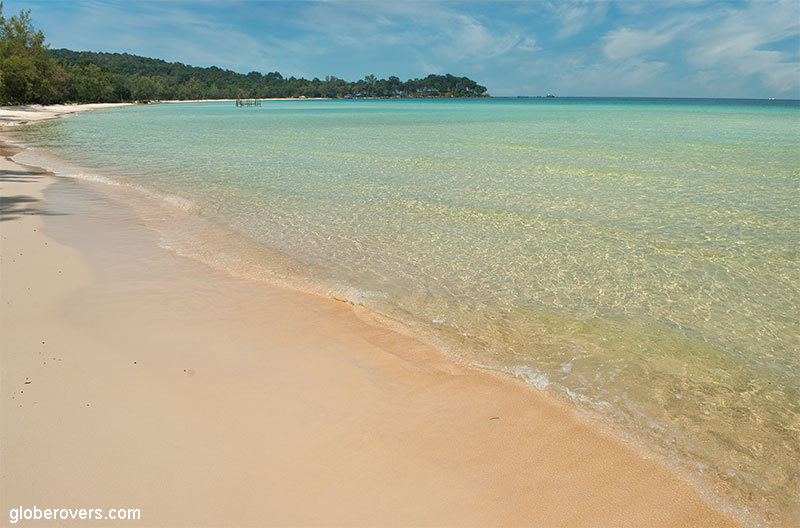
Among the biggest islands, most of which still have insignificant tourism, are Koh Kong, Koh Rong, Koh Rong Sanloem, Koh Ta Kiev, Koh Thmei, and Koh Seh. In addition, there is a slew of small islands of which just a few offer tourist accommodation.
Generally speaking, Koh Rong has a bit of a partying vibe while its sister island to the south, Koh Rong Sanloem, is known for its super relaxing atmosphere.
Looking to indulge in luxury, check out the resort on Koh Song Saa as well as on Koh Rong and Koh Russey. Nature watchers should head to Koh Thmei, while if relaxing all day in a hammock is your top priority, then Koh Ta Kiev is your island – and really so are all the islands!
Want to disconnect from your regular life and do serious beachcombing, then Koh Totang is the place to be. However, other than partying, all the islands offer serenity!
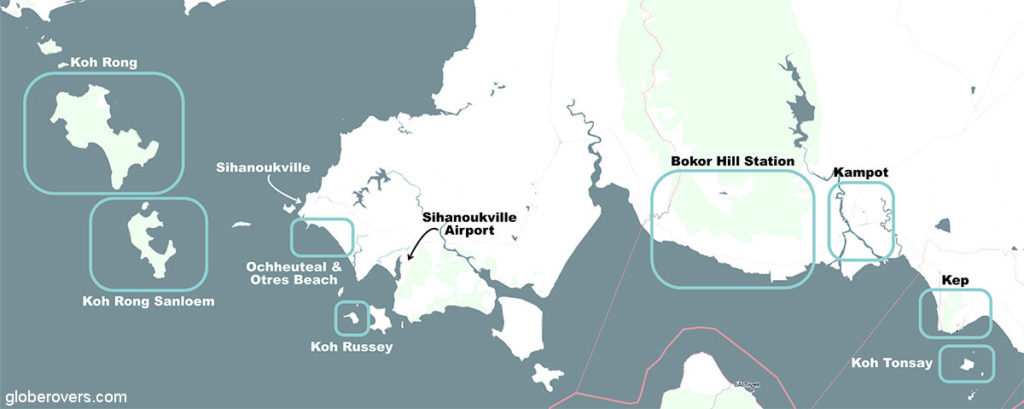
Why Travel to Cambodia’s Islands?
- The Low-Down: Who doesn’t want to be on an idyllic beach with crystal clear turquoise waters and few tourists. You will find it here on Cambodia’s islands but hurry up as developments are in the pipeline to transform these lonely islands into bustling tourist spots.
- The Brightest Highlight: While there are many beautiful and lonely beaches on these islands, the top prize is shared between Clearwater Beach in the northeastern part of Koh Rong Sanloem, and San Sok Beach on the southwestern part of Koh Rong Island.
- Intrepid Destination: Many parts of even the busiest islands are not busy compared with the islands of Thailand. Especially when visiting during low season, the beaches are all yours!
- GlobeRovers Score (10 is the highest): Cambodia’s islands still remain fairly undeveloped with many beaches devoid of any development. Spend 3 or 4 weeks here and try to visit as many islands and as many beaches as you can. You will be delighted! It gets a score of 9.1 out of 10.

While there are so many islands to explore, in particular if you rent a private boat, only a few have regular ferry services from the mainland. Come along as we visit a couple of these islands. We start in the south at Tonsay Island and then head further north along the coast to Koh Russey, Koh Rong Sanloem, and then Koh Rong.
Table of Contents
Koh Tonsay
For a slice of rustic island life, complete with hammocks and swaying palm trees, hop on one of the former fishing boats converted into tourist ferries, for the 30-minute ride to Rabbit Island, or Koh Tonsay as it is known in the local Khmer language.
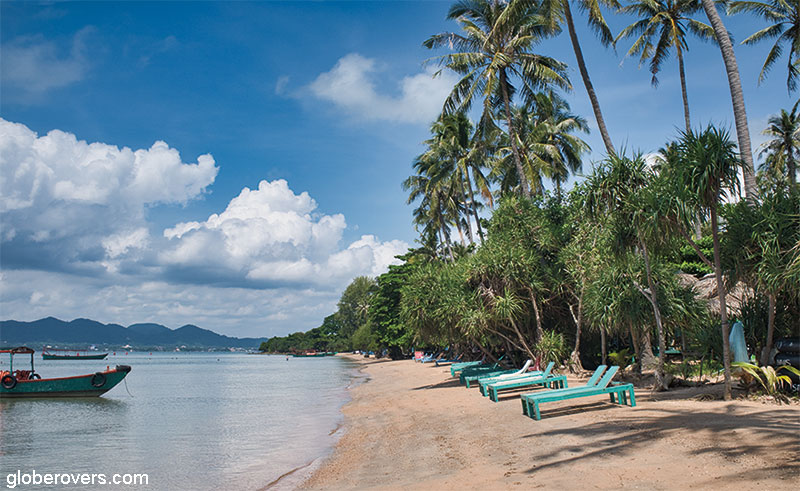
While most travellers to the island are day-trippers from the mainland, the west coast beach is lined with threadbare bungalows and restaurant shacks.
An island with palm-fringed beaches and a lot of golden sunsets.
The island relies on solar power and generators for its electricity. No vehicles are allowed as there are no roads except for a footpath down the 250 metre (820 foot) long beach. While the footpath encircles the island, according to a friendly bungalow manager, this path mostly disappears along the eastern and northern sections.
Walking all around the island is not nearly as easy, or idyllic, as it appears on the map, and is not recommended to anyone but lovers of mud, spiders, long grass, beach garbage, and hook-thorn shrubs.
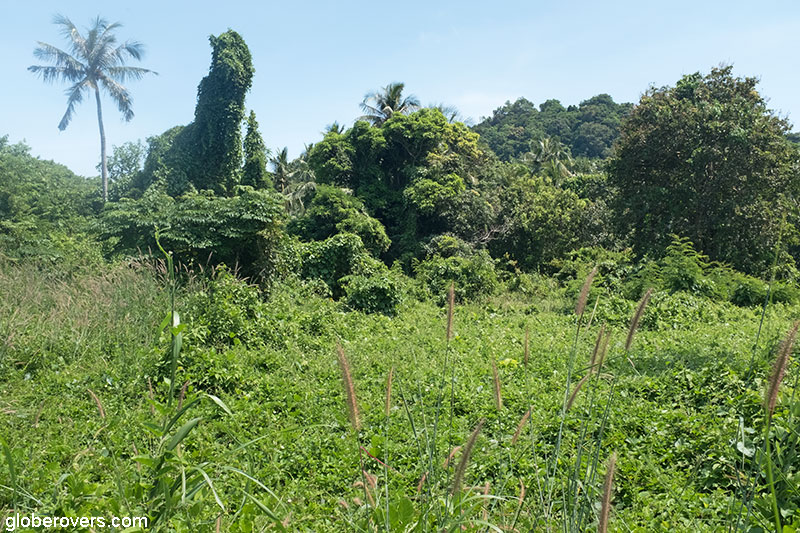
If decent beaches, hammocks, swaying palm trees, sunsets with cocktails, and drifting off to the sound of the waves best float your boat, then make sure to spend a few days on Koh Tonsay. When the peace and quiet become too overwhelming, rent a small boat for a day trip to the nearby islands of Koh Svay (Mango Island) and Koh Pos (Snake Island).
Most huts are rudimentary, however the bungalows of Khim Vouch Lay at the southern end of the beach are superior, though not significantly more expensive than the rest.
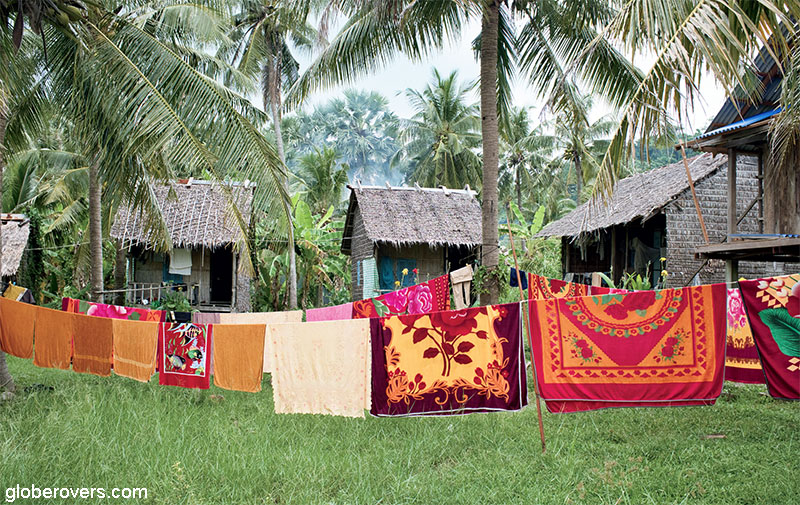
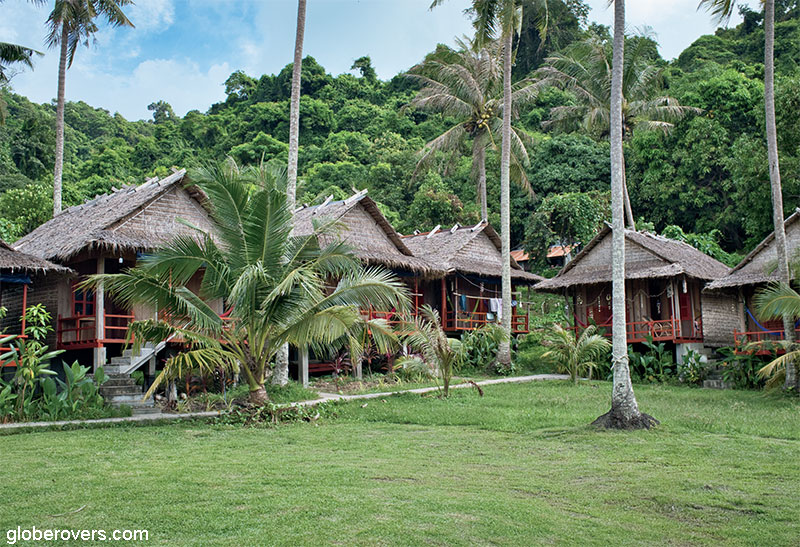
Koh Russey
To the south of Otres Beach on the mainland lies Koh Russey, also known as Bamboo Island. The island measures roughly 900 metres (0.6 miles) by 1.5 kilometres (0.9 miles) and can be reached by a 20-minute car ride from the Sihanoukville International Airport and then 10 minutes on a ferry.
Koh Russey is bestowed with a beautiful coastline, dramatic headland, tropical forests, and powdery sand beaches.
The main reason for visiting this private island is to be pampered at a fine resort.
For decades, the undeveloped island served as an outpost for the Cambodian Navy but with the rise of tourism to the region, the government was seduced by the almighty tourist dollar. The island is now managed by CityStar, a French private equity firm.
In cooperation with the Alila Hotels & Resorts Group, that is part of Hyatt Hotels, they operate the splendid Alila Villas Koh Russey Resort located at the northern end of the island. It was reportedly the first resort in Cambodia to receive the highest level of certification by EarthCheck for its efforts to reduce environmental impact.

In early 2020, it was announced that Hyatt, under the Alila brand, would no longer be managing the resort. Only time will tell who next will manage these beautiful facilities.
UPDATE: January 2021: Alila Villas Koh Russey Resort is now under new ownership and managed by “Small Luxury Hotels of the World” and has been renamed as The Koh Russey Villas & Resort.
The resort’s 63 pavilions and beachfront villas are immaculate with all the comforts you can expect at a luxury resort of distinct taste. Among the wide variety of amenities available to guests are a large infinity beach pool, a restaurant, yoga room, fitness centre, spa, and souvenir shop. The jungle’s beauty and tranquillity, including several large Banyan trees, are a few steps away from the villas.
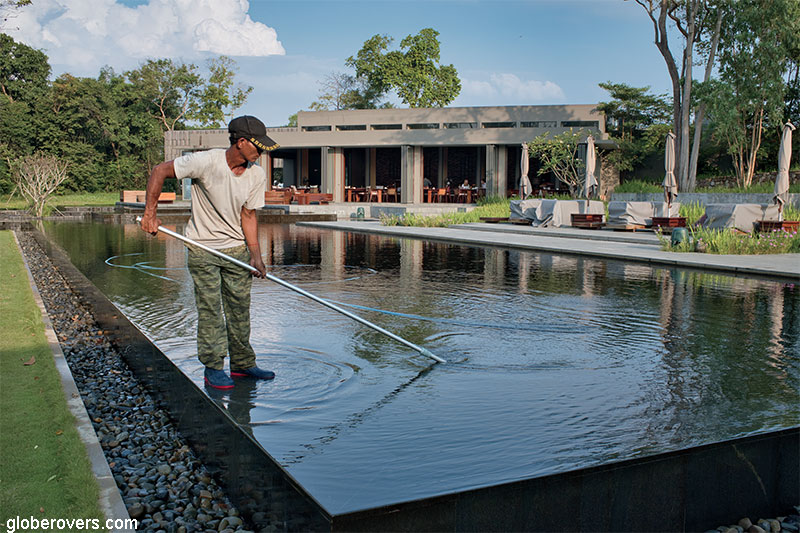
Just about two kilometres (1.2 miles) east of Koh Russey lies its much larger sister island, Koh Ta Kiev, an unspoiled military-owned island with a long copper-sand beach. Most of Koh Ta Kiev’s quiet charm comes from the island’s lack of development. Accommodation options here vary from rustic treehouses in the jungle to a stunning eco-resort.

Back on the mainland near the airport, the Ream National Park offers a unique opportunity to discover the local wildlife. Several centuries-old trees, as well as rare bird species, can be spotted around the park. It is fascinating to cruise through the mangroves on a small boat before walking along a path for a closer look at the rich biodiversity and the humming sounds coming from within the dense mangroves.
Koh Rong Sanloem
From north to south, clockwise, the main beach on the north side of Koh Rong Sanloem is MPay Bay (a small village integrated with tourist facilities). Along the eastern side are Clearwater Bay (and empty and idyllic beach under development by mainland China) and Saracen Bay (the longest and busiest beach). Along the west coast are Buck Beach, Lazy Beach, and Sunset beach.
Let’s explore most of these beaches!
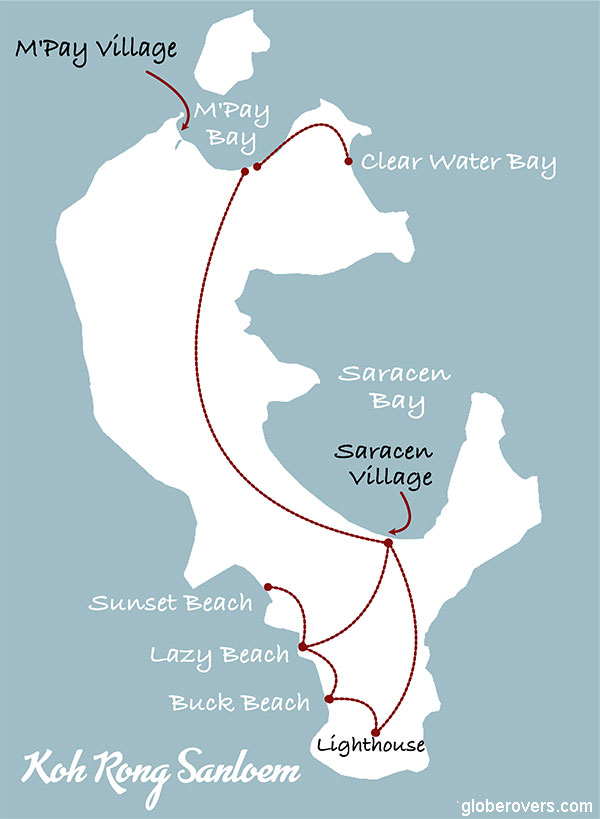
1) M’pay Bay
M’Pay Bay sits at the northern end of Koh Rong Sanloem island and is well protected against the high surf by the nearby island of Koh Koun. A Khmer village is located at the northwestern end of the bay. Almost all the beachfront houses of the village have been converted into travellers accommodation, restaurants, and shops. Further away from the beach, the locals are trying to live fairly normal lives.
Koh Rong Sanloem’s most northern bay has a well-developed backpacker scene
During peak season, M’Pay Bay can be quite busy as the traveller infrastructure is well-developed and it is a popular hangout for backpackers. Outside of peak season, it has a more subdued atmosphere.
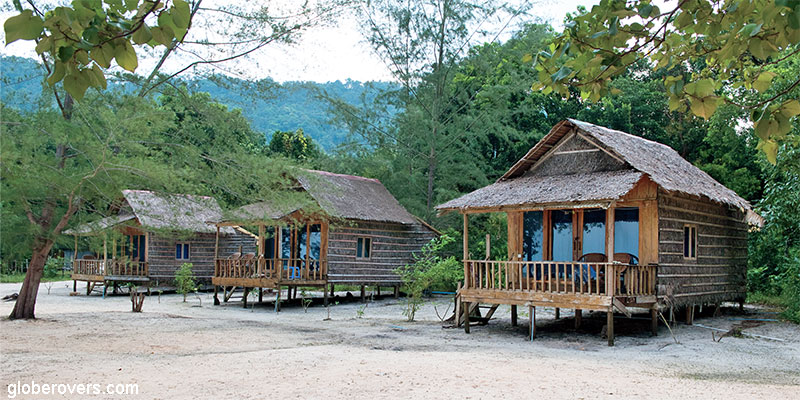
In addition to the many restaurants serving drinks under the trees along the north-facing beach, are a few rustic sunset bars along the northwestern side of the island.
These bars are a few hundred metres walk up the hill past the village. Perched high on the cliffs over the sea, some bars worth checking out are the Lookout Bar, Dragonfly Bar, The Cliff Bar, and On The Rocks Bar. During peak season, arrive at least an hour or two before sunset to secure a seat and watch the sunset with a cocktail in hand.
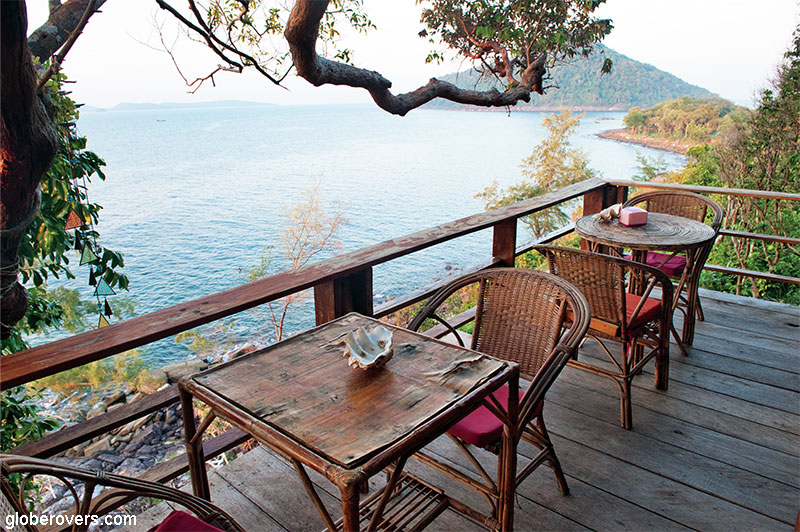
During high and peak seasons, M’Pay Bay can be reached from Saracen Bay (Orchid Pier), the main beach on Koh Rong Sanloem.
There are also ferries from Sihanoukville on the mainland, and from Koh Touch Beach on Koh Rong Island to the north.
2) Clearwater Bay
While M’Pay Bay beaches are generally clean and fit for swimming, the best beach in the area, and also one of the most beautiful in Cambodia, is at nearby Clearwater Bay.
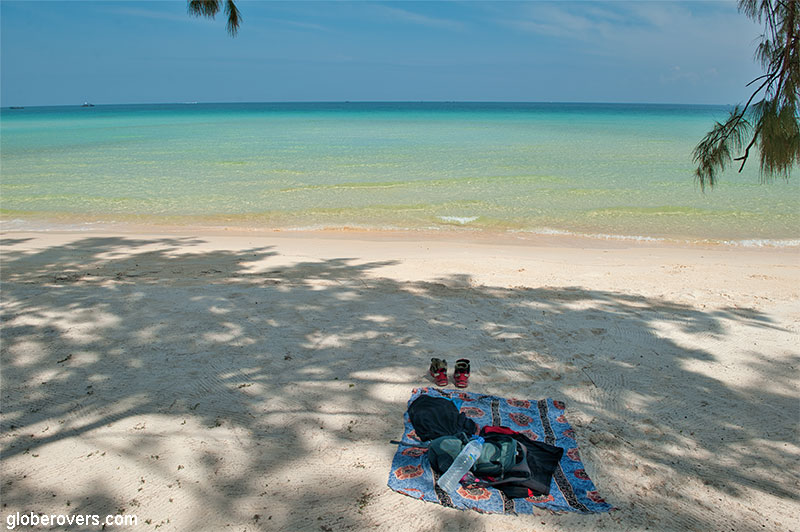
The bay lies across the northeastern headland of the island and requires a one-hour hike from M’Pay village. Walk to the eastern end of M’Pay Bay beach to where a small signpost announces “Clearwater Bay” to the right and up the footpath through the jungle.
One of the most beautiful and unspoiled beaches is now slated for development
Until early 2019 it was easy to follow this winding path through the thick forest. However, Chinese developers staked out a huge swatch of land here and their earth-moving equipment has destroyed patches of the jungle for a new resort.
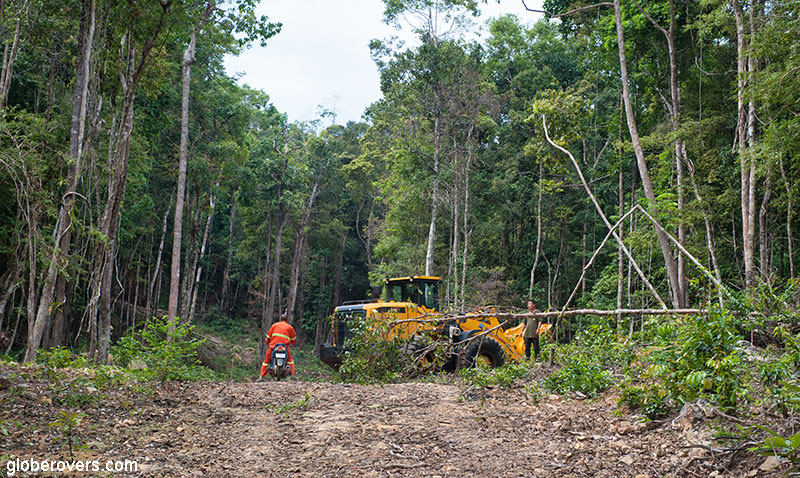
The path has now disappeared in some sections so it has become more challenging to get to the bay, even more so when returning to M’Pay village. If and when this large resort opens, the pristine natural attractions here will unquestionably be disturbed, if not destroyed.
Up until 2018, the rustic Driftwood Hostel and Bungalows were a welcome oasis on this 2.2 kilometre (1.4 mile) long gorgeous beach. Managed by an Australian backpacker and staffed by volunteers, it offered five bungalows and a few dorm rooms with a spacious dining room.
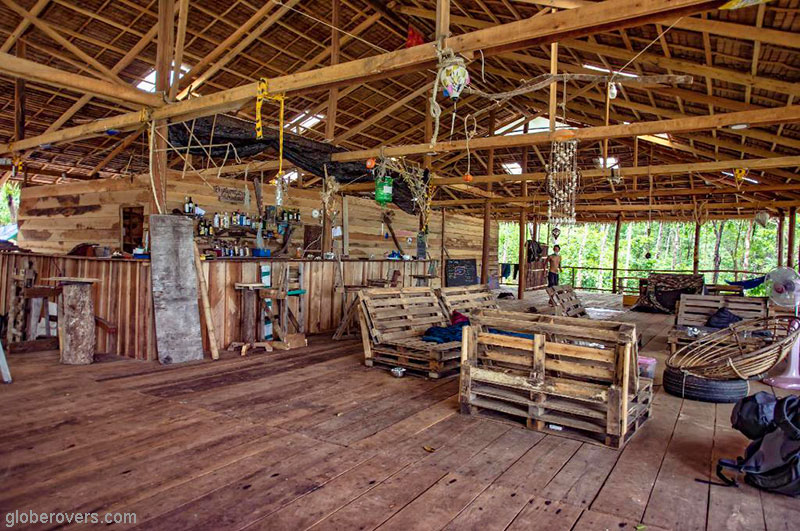
The rickety wooden building sits near the beach on stilts high above the sand, the only place to sleep and have drinks in the entire bay. The Chinese developers have now pushed the Driftwood out and since 2019 the building stands unoccupied except for a few locals squatting in the large open space of the living room.
In May 2018, a few months before the demise of the Driftwood, travel blogger “Roaming Reece” posted photos of the Driftwood with his fond memories of staying there and enjoying the beaches. He concluded his post with: “I would definitely visit Clear Water Bay again and take a tent with me. While I was there I heard a Chinese company had bought a large chunk of the island, so how long this carefree beach is going to survive, I don’t know!”
Now we have evidence that a China-owned resort will soon open so the days of this carefree beach will soon be gone — unless the Cambodian Government steps in and stops the project before it is too late. Sadly, good things don’t last forever.
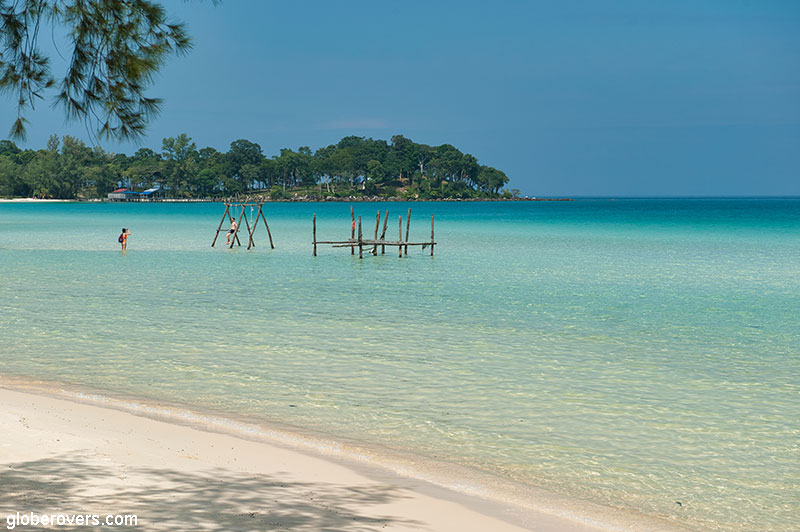
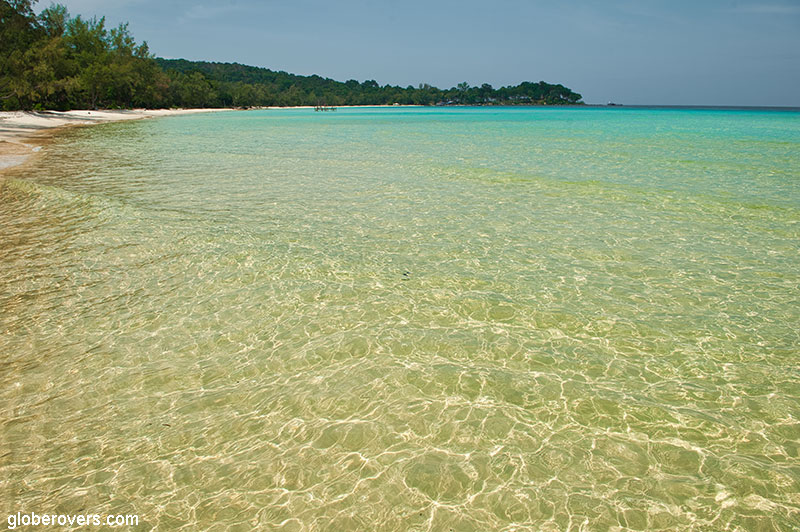
3) Saracen Bay
The main tourist beach on Koh Rong Sanloem is at Saracen Bay on the southeastern side of the island. Easily accessible by ferry from Sihanoukville, this three kilometre (1.9 mile) long beach has a pier at both the northern and southern ends.
While this beach can get touristy, the vibe is great, in particular at sunset
Almost the entire stretch of the beach is covered with resorts, varying from budget to luxury, most of which have a restaurant and bar on the beach. On average, accommodation and food on Koh Rong Sanloem are more expensive than on Koh Rong Island to the north.
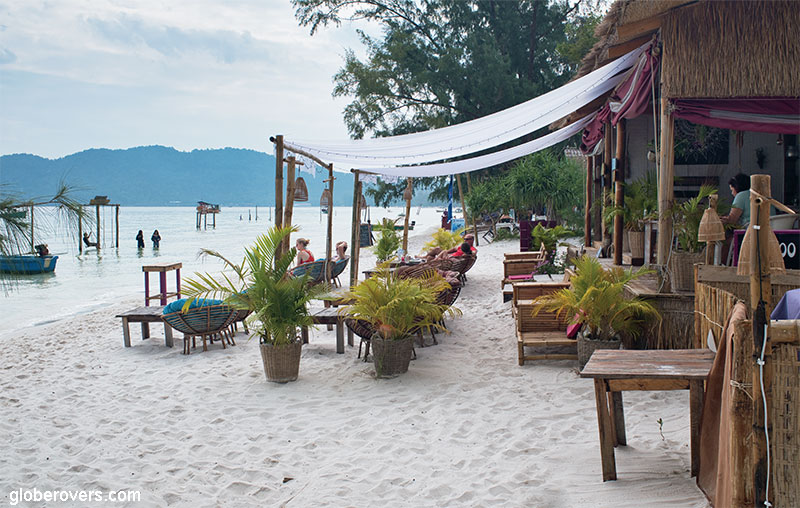
At the northern end of the beach a few hundred metres into the jungle, is the Freedom Waterfall, which is worth a visit, especially during the rainy season. The jungle surrounding the waterfall is rugged and the natural pool of fresh water is perfect for swimming. The waterfall comes with a bar and a restaurant with decent Khmer food.
The coral reefs around the island are still in a fairly good condition and snorkelling and scuba diving should be on your list.
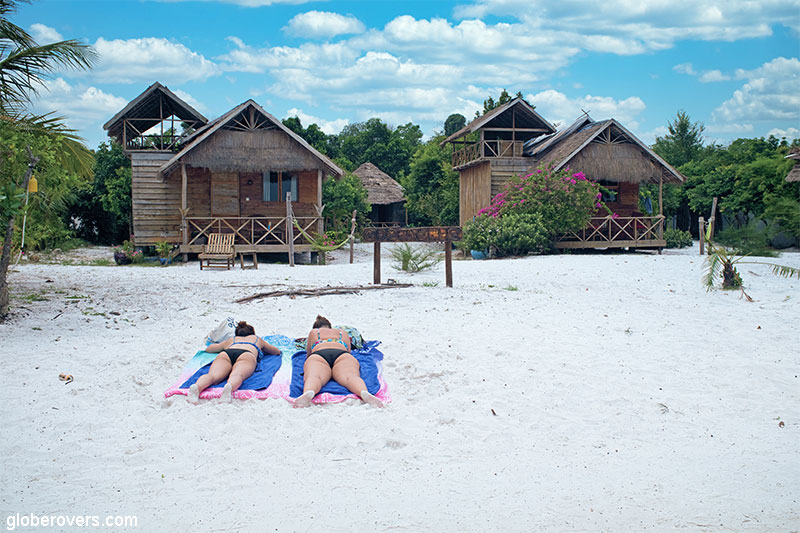
At night, some areas around the island come alive with the sparkling blue colours of bioluminescent plankton. After dark, preferably on moon-free nights, wade chest-deep into the sea, face away from the beach lights and wave your arms underwater to see the “fireflies of the sea” come alive.
The jungle in the northern half of the island is still largely untouched, while large patches of the southern side of the island have been deforested at an alarming rate. It would be an adventurous jungle hike all the way from M’Pay Bay in the north to Saracen Bay, before more of the jungle disappears.

Almost four kilometres (2.5 miles) south of the bottom end of Saracen Bay is the Koh Rong Sanloem Lighthouse. The hike from the beach takes about 70 to 90 minutes and the small path goes up the hill. It is best to do this hike early in the morning but bring along enough water and sunscreen. The views from the top of the lighthouse are splendid.
4) Western Beaches
While Saracen Bay on the east side of Koh Rong Sanloem has the longest and most developed beach, the west side is blessed with three small unspoiled beaches, each with a special charm.
From south to north, the beaches are Buck Beach, Lazy Beach, and Sunset Beach. All of them are fit for swimming and offer perfect views of the setting sun over the Gulf of Thailand.
The beaches on the western side of Koh Rong Sanloem remain mostly undeveloped
While all three beaches have direct hiking paths from the beach at Saracen Bay, they can also be approached via a coastal hiking path starting at the lighthouse.
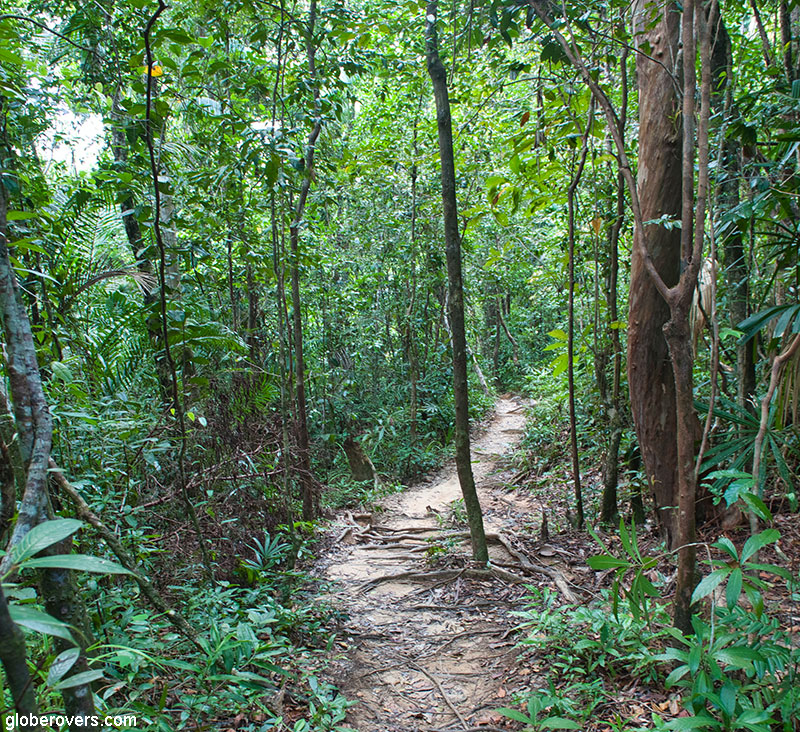
From the lighthouse, follow the path back to Saracen and at the first crossroad, turn left and follow the path down to Buck Beach, which is visible from the top of the lighthouse. The beach is normally quite deserted and great for swimming.
Walk north along the Buck Beach right up to the end. Set about 15 metres (50 feet) back from the sea is a hiking path that snakes through the thick jungle all the way to Lazy Beach. The beach is beautiful and the water perfect for swimming.
The only accommodation and restaurant is at Lazy Beach Resort which offers twenty simple cabins and a large open-air main lodge serving food, drinks, and snorkelling gear rental.
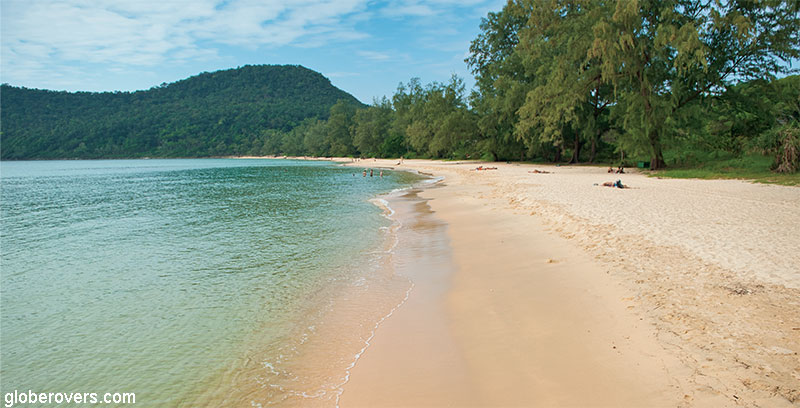
From Lazy Beach the hiking path continues through the jungle north to Sunset Beach. Parts of this path, especially the last section before arriving at the beach, are somewhat challenging.
Sunset Beach looks similar to Lazy Beach though it is shorter and has more large trees right on the beach. Here are a few restaurants and accommodation options, including beach camping, as well as a couple of adventure operators.
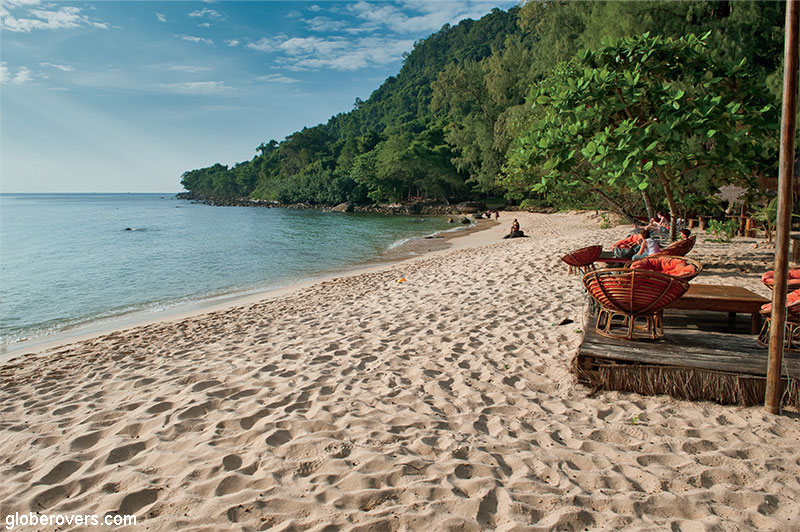
Enjoy a drink at the cosy Huba-Huba bar at sunset, but only if you are staying for the night. If not sleeping over, then it’s better to head back to Saracen before the jungle falls into complete darkness.
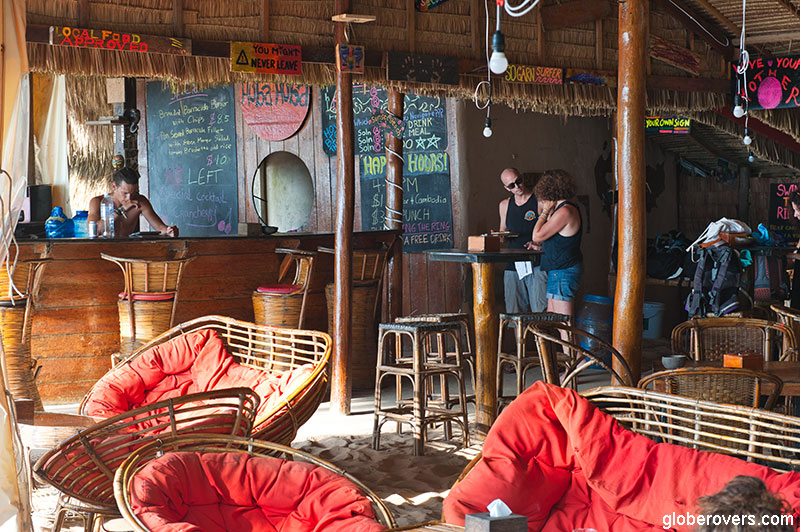
Koh Rong
The larger of the two sister islands, Koh Rong, liest to the northwest of Koh Rong Sanloem.
From north to south, clockwise, the only beach on the north side of Koh Rong is Lonely Beach (a hard to reach beach with swaying palm trees and basic bungalows). Along the eastern side are Palm Beach, Nature Beach, and Coconut Beach. In the southern end is Long Set Beach (4k Beach) and the busiest beach, Kaoh Touch. Up along the west side is the long San Sok Beach and its village at its northern end, and further up along the coast is the small Thansour Beach.
We picked a few of the best beaches on the island so come along as we explore Lonely Beach, Coconut Beach, and arguably one of the most beautiful beaches in the region, San Sok Beach.
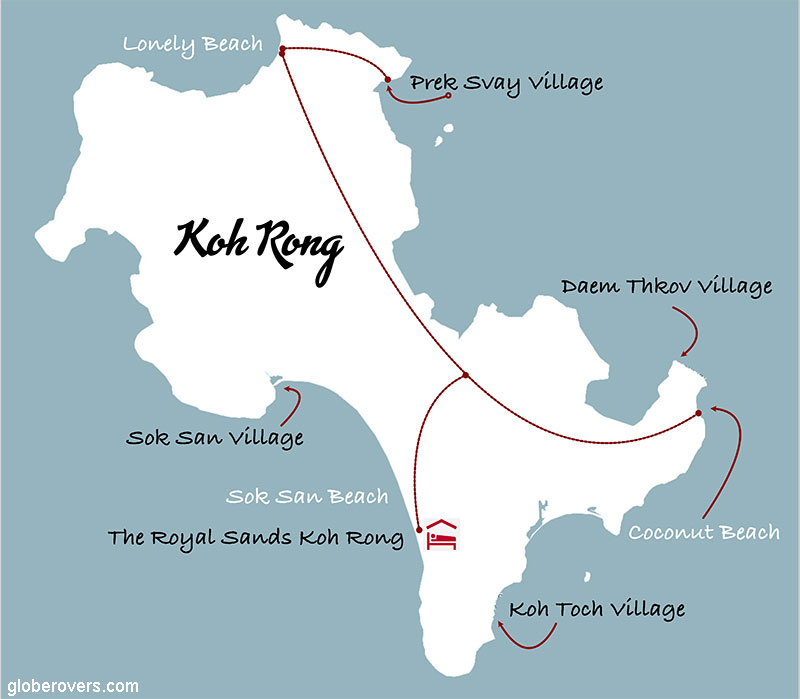
1) Lonely Beach
Lonely Beach is located at the northern tip of Koh Rong Island. This beach offers a paradise-island-feel with its tall overhanging palm trees, crystal clear ocean waters, and soft brown-white sandy beaches. This beach is also one of the very best spots in the area to see the colours of bioluminescent plankton at night.
Hard to get to and with only one bungalow operator, Lonely Beach is a gem!
The French-owned Lonely Beach Bungalows is the only accommodation available on this part of the island. It offers bungalows with an ensuite bathroom, a gazebo style dorm with beds under mosquito net canopies, as well as a few cheaper huts referred to as “birdnests” with wooden window enclosures and no bathroom.
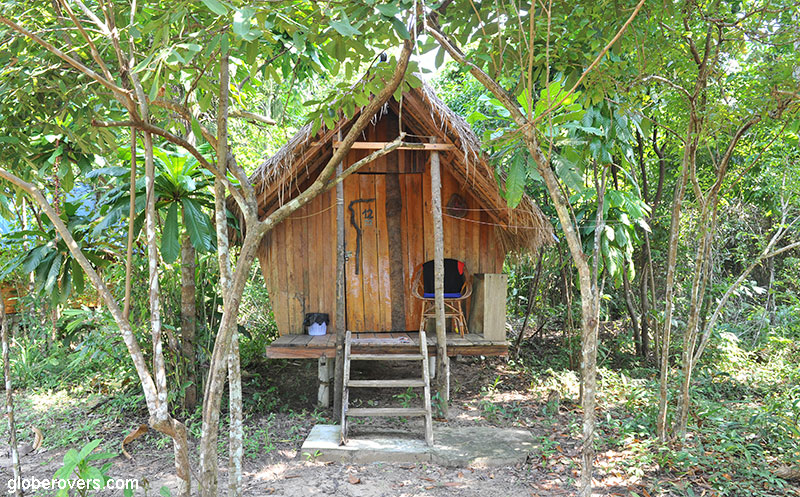
All accommodation here is very basic and not suitable for anyone looking for reasonable comfort during their stay. However, if staying in a rustic bungalow is your way of being at-one with nature, then this place should be perfect.
The bungalows and the restaurant are several metres away from the beach so the beach remains devoid of any buildings. A few hammocks have been set up between the palm trees on the beach so it is easy to laze away on this serenely lonely beach.
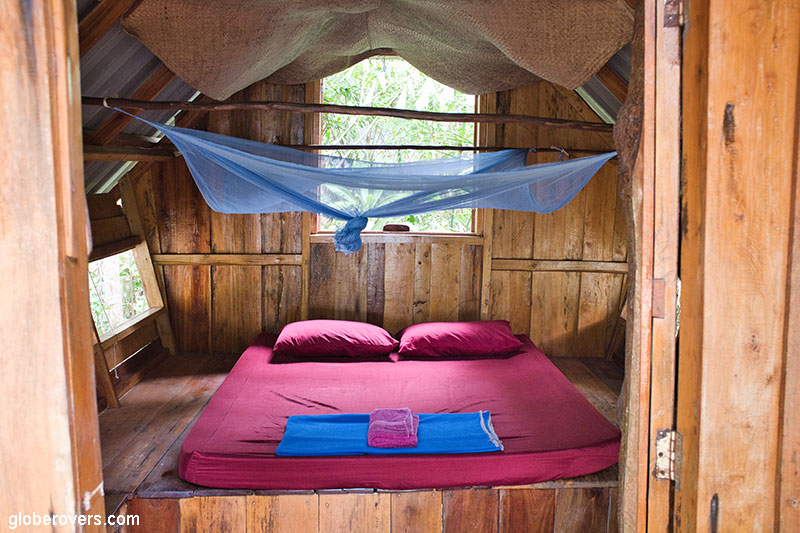
The spacious restaurant serves decent food, though prices are significantly higher than at similar places on the rest of the island.

This part of the island is hard to reach during off-peak periods when boats are limited. The bungalow owners offer non-scheduled boat transfers from Sihanoukville as well as to the beaches around the island, but unless you are in a large group, their boat is very expensive.
A 45-minute adventurous hike from Lonely Beach across the northeastern tip of the island leads to Prek Svay fishing village. The path goes through some muddy sections and a small stream. Snakes are omnipresent on these islands, so walk cat-foot. This friendly village has many houses built on stilts over the water, including the very basic Firefly Guesthouse with a few rooms and a restaurant serving up local dishes. The village is the centre for marine conservation on the island, thanks to several NGOs at work here.
The temple on the outskirts of town has its interior entirely adorned with Buddhist paintings and is well worth a visit.
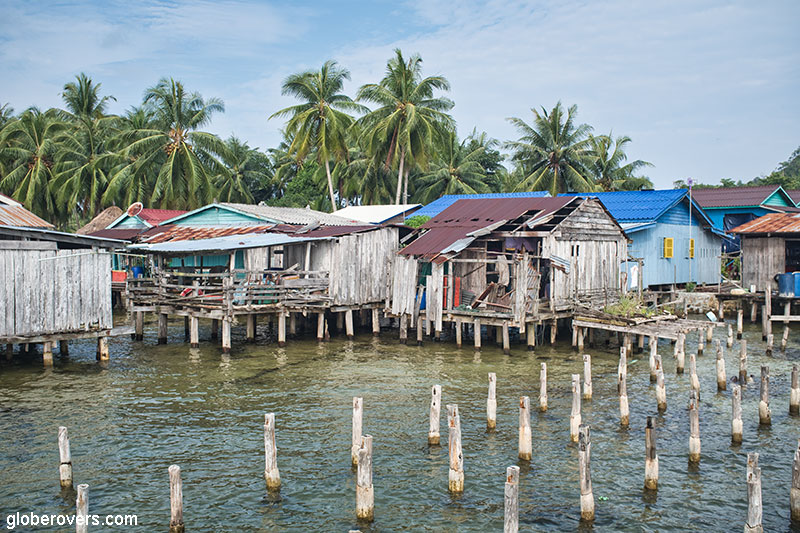
A few kilometres south of the village is the small secluded Palm Beach. About a kilometre away from the beach are two tiny islands named Koh Bong and Koh Oun, meaning “the sweethearts” or “boyfriend and girlfriend islands”. These days they are more commonly referred to as the Song Saa Private Islands, home to Song Saa, an exclusive eco-resort. The islands have been meticulously redeveloped with great care given to supporting the local environment and marine life.
2) Coconut Beach
Coconut Beach lies at the southeastern tip of Koh Rong, 19 kilometres (12 miles) by road south of Lonely Beach. While it is possible to arrange a comfortable private boat transfer from Lonely Beach, a more economical and adventurous way is by motorbike taxi.
Much of this road is a lonely footpath through the northern part of the island, though the southern section becomes wider until it turns into a gravel road.
Coconut Beach is one of the most popular backpacker beaches on Koh Rong
The northern part is truly an adventure as the footpath often disappears in the jungle, or under big puddles of rainwater. Where there is too much mud, the motorbike must be driven on some rickety wooden planks placed over the mud.
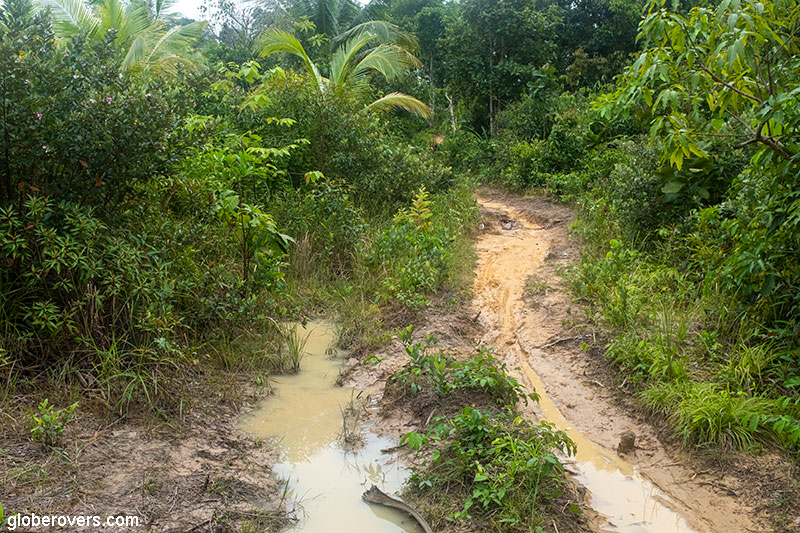
While Coconut Beach ticks off all the essentials: clear turquoise waters, white sand, palm and coconut trees, bungalows, restaurants, and bars, it is not one of the best beaches on these islands. The beach is well-developed and offers a wide variety of bungalows, beach restaurants, and even beach parties with bonfires at night.
It is a popular backpacker hangout so the hammocks near the beach are often still occupied late in the morning with those who can’t get their eyes open after a late night of indulging in cheap Cambodian liquor.
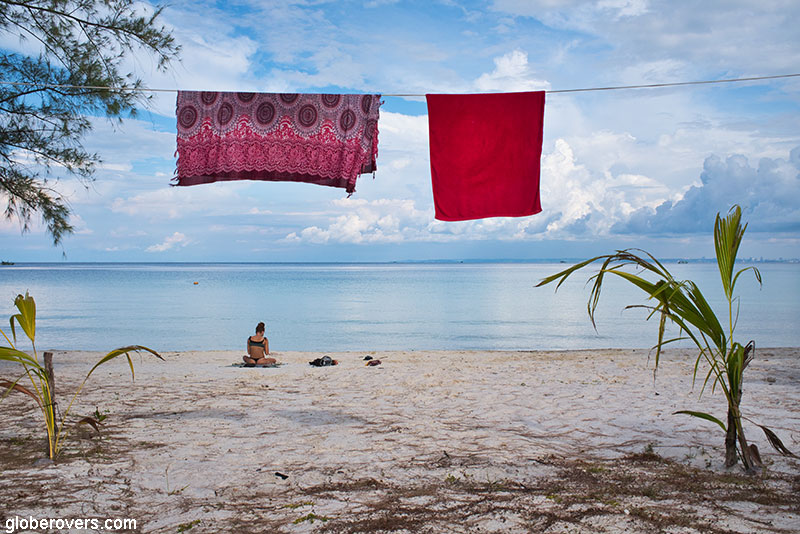
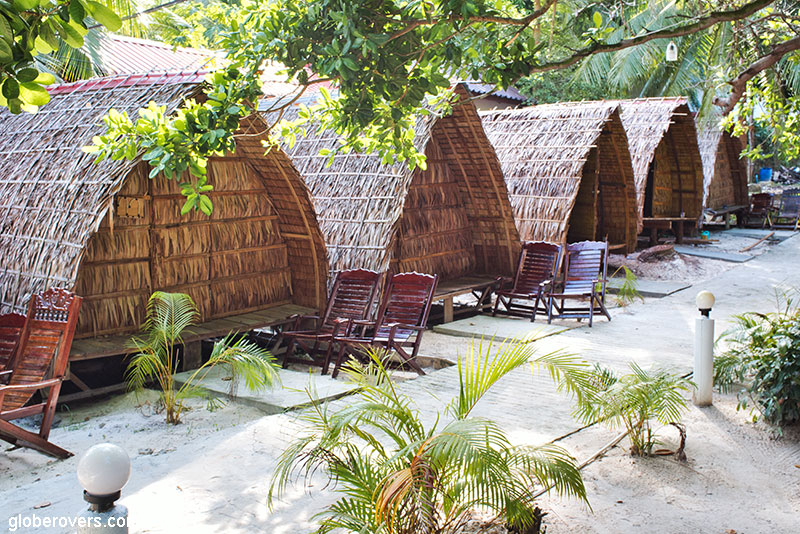
The backpackers are mostly found at the permanent tents on the beach offered by the Coconut Beach Bungalows which is set on a hillside close to the beach.
A small footpath north up the hill from the beach leads to Daem Thkov fishing village. The village offers at least one very basic guesthouse and an even more basic restaurant. It is best to sleep at Coconut Beach and visit the village for an hour or two to mingle with the locals and have a few laughs with the inquisitive kids.
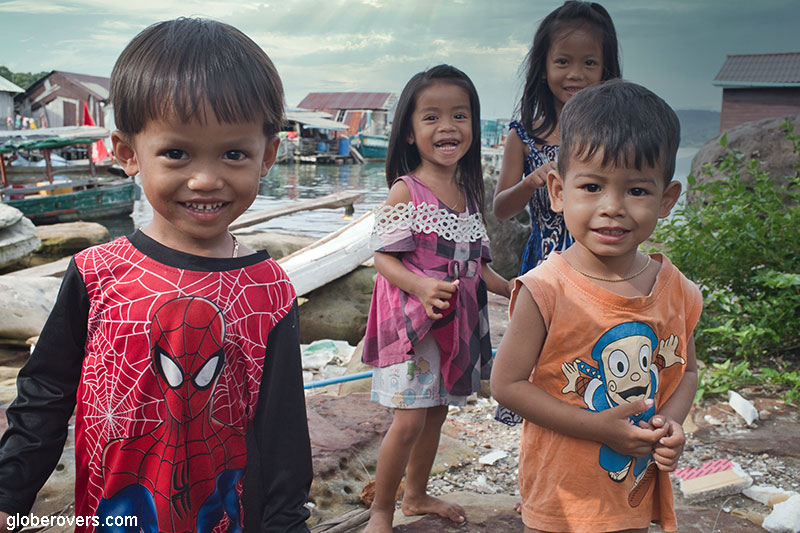
3) Sok San Beach
From Coconut Beach the small bumpy motorbike road winds through jungle clearings for about 15 kilometres (9 miles) to Sok San Beach and its village on the west coast of Koh Rong. This beach is now more commonly referred to as Long Beach.
A long white beach with crystal clear waters and a small friendly village
At the northern end of the beach, in a beautiful location, lies Sok San village. The villagers must have noticed the influx of the almighty tourist dollar at Koh Touch village on the other side of the island and didn’t want to be left out of the action. In response, they have transformed several of their village houses into guesthouses, and erected many new basic bungalows, most without sea views.
The stylish Khmer-style Sok San Beach Resort sits on the southern edge of the village.

While staying at a guesthouse in the village offers an authentic experience of local Khmer life, the tourists are having both a positive and negative impact on their way of life. Fact is, this lazy fishing village will never be the same again.
The village has a functional pier for the fishermen which is an excellent spot in the early mornings to watch the villagers going about their daily tasks. The single small street in the village has several stores and food shacks that offer cheap and tasty local snacks for hungry travellers.
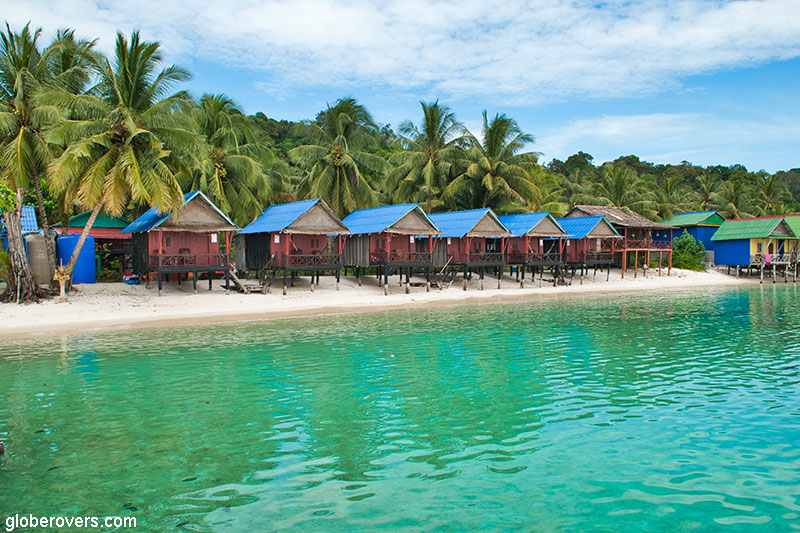
Not far from the village is the Sok San Waterfall, located in a tranquil setting. It is best seen during the rainy season as during the dry season it is mostly without water.
In the late afternoon, settle down at one of the many sunset bars with a drink and listen to a mix of Cambodian, Thai and Western love songs.
The beaches around the village are beautiful and the water a deep turquoise colour. Swimming is best south of the village on Sok San Beach.
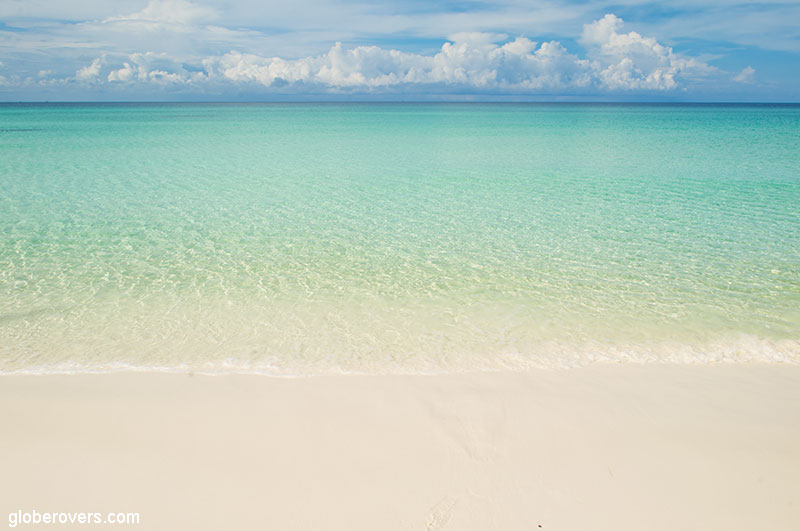
Sok San Beach is about 5.5. kilometres (3.4 miles) long and is arguably the most beautiful beach in all of Cambodia, and one of the best in Southeast Asia. The waves are smooth, the water is crystal clear, and the white sandy beach is mostly free of any washed-up rubbish. Fortunately, much of the beach remains undeveloped, except for a few guesthouses set back from the beach.
A few minutes walk south of the village are the bungalows of the Long Beach Resort Koh Rong. This new resort has fairly basic but comfortable air-conditioned rooms with free WiFi, each with a private bathroom and a restaurant that serves Asian and European food.

A little further south are the more basic bungalows of the Soksan Natura Beach.
The gem on this beach is The Royal Sands Koh Rong Resort close to the southern end of the beach. This 5-star resort spans a private 500-metre (1,640 foot) stretch of pristine, soft, white sandy beach which descends into crystal clear turquoise water.
Its 67 elegant villas, all with sea views, are designed to offer an atmosphere of luxurious relaxation and incorporate high-quality and sustainable materials including teak, bamboo and limestone. The open-air venues have unspoilt views of the Gulf of Thailand and its legendary sunsets.
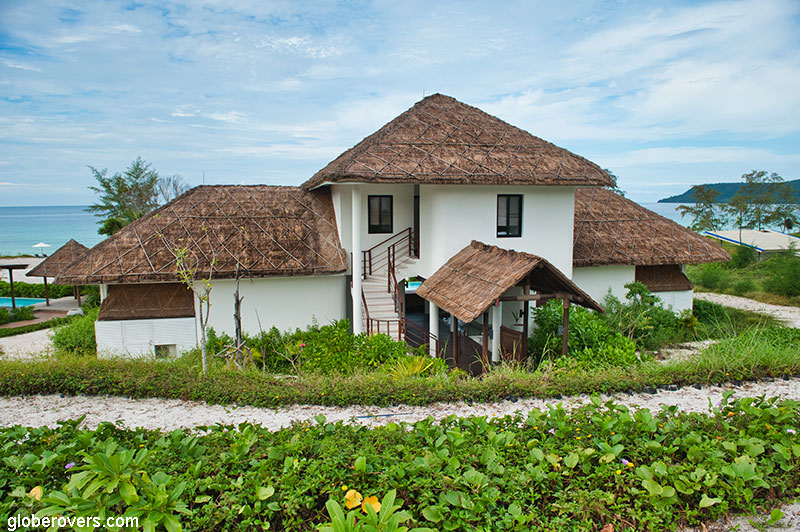
All villas offer an outdoor ‘salas’ lounge with a day-bed, while some feature beachfront views and a personal pool. The bedrooms are spacious and allow guests to enjoy sea views from their bed. Bathrooms are equally spacious and feature indoor and outdoor rain showers. The larger villas have two and three bedrooms, each with their own private pool overlooking the sea.
This place is truly a serene and luxurious escape for the mind, body, and soul. The hotel provides a 40-minute private boat service from Sihanoukville, as well as private taxis around the island and helicopter pickups.
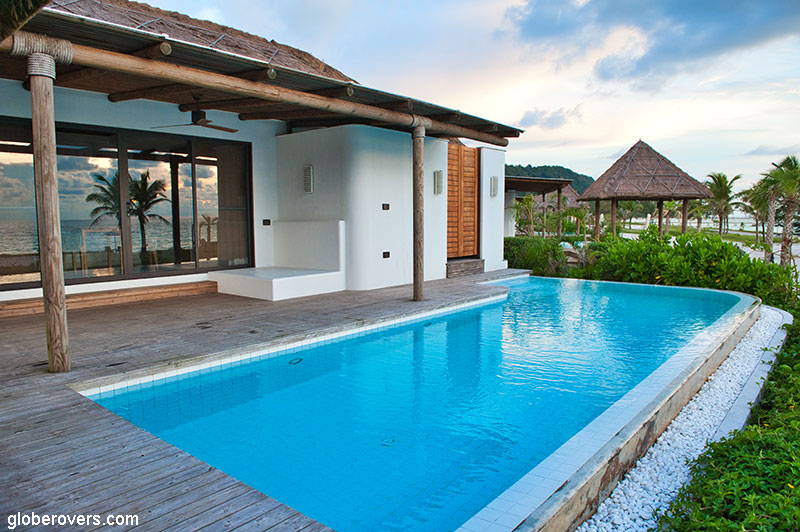
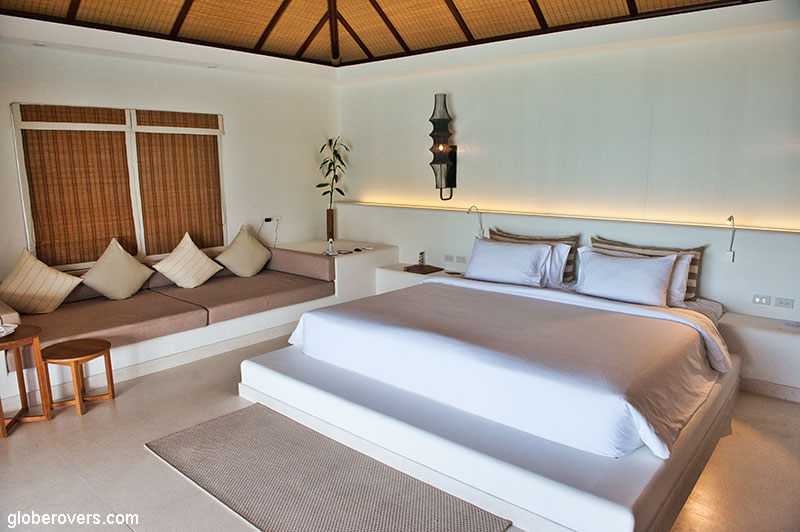
While it would be awesome to stay at The Royal Sands Koh Rong indefinitely, your budget may not allow for that so it’s time to leave Cambodia’s paradise islands. The next hotel ferry leaves at 9 am to Sihanoukville from where the taxi ride to the airport takes about an hour.
Hope you have enjoyed your trip to southern Cambodia and are taking home lots of beautiful memories.
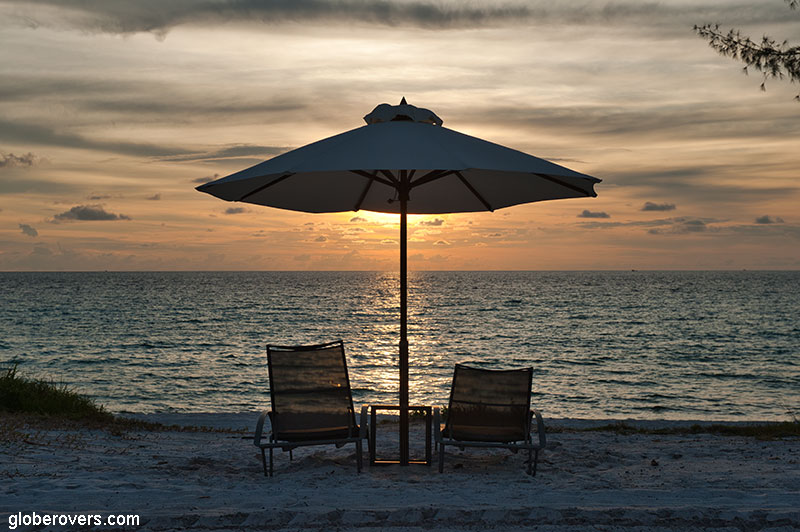
☛ Read more: Coastal Towns of Cambodia
Essential Information
Getting There
To get from Sihanoukville to Koh Rong, or to get from Sihanoukville to Koh Rong Samloem, take one of the 5 modern ferry companies – Speed Ferry Cambodia, Island Speed Boat Cambodia, Buva Sea, Angkor Speed Ferry, and GTVC. Ferries also run between the two islands and stop at a few beaches.
Getting Around
There are boats and ferries that connect the islands. While on the islands, it is best to hike or hop on a motorbike taxi (where available) to travel among the beaches. There are no taxi cars (or any cars) on these islands. The odd place may have a motorbike or bicycle for rent. If no ferry passes by the beach you want to reach, then hire a private longtail boat.
Photography
Photographers come to Cambodia to capture the palm-fringed white-sand beaches with turquoise water, authentic fishing villages, abandoned villas and beautifully restored colonial buildings, as well as the people in their daily lives who are generally happy to have their photos taken.
When to Go
The best time to visit southern Cambodia is during the dry season between November and April. High season is from mid-November to the end of January, with more expensive accommodation and limited rooms. May and October can be very nice while June to August can be very wet.
Where to Stay
While much of the accommodation in southern Cambodia is backpacker to mid-priced bungalows and huts, there are a few luxury resorts for those who want a more refined stay. Consider The Royal Sands Resort on Koh Rong island and the Koh Russey Villas & Resort (previously known as the Alila Villas) for an awesome splurge.
Safety
The south of Cambodia is quite safe and free of landmines. Like everywhere else, be alert for pickpocketing, overcharging and scams, although these are rarely reported. When cycling, be careful with valuables in the carry basket. Most dangers here are in the sea and the jungle, though don’t worry too much as there are not great white sharks or tigers.
Dining Out
On the islands, except in the luxury resorts, the food is quite basic and Thai dishes are common. While the busy beaches have many restaurants along the beach, if you are staying at one of the more remote beaches you may only have the choice of your bungalow restaurant.
Train Travel
A regular passenger train service between Phnom Penh and Sihanoukville, with a stop in Kampot, commenced in May 2016. There is one train a day on Fridays and Saturdays and two on Sundays. It takes around 7 hours 30 minutes to travel the 264 km (164 mi). Trains leave Phnom Penh in the early morning or late afternoon and cost US$7 one way.
Cost of Travel
The cost of travel in Cambodia obviously depends on how much you want to spend. Accommodation varies from US$7 per night for a tent on the beach, to US$5,000 dollars in a luxury resort. Generally, the cost is similar to Vietnam, cheaper than Thailand, but not as cheap as Laos.
☛ Read more: Blog posts of Cambodia


Blog post and photos by Peter who has been travelling almost full-time since 2005 and has been to over 122 countries. He visited several countries, such as Japan, more than 20 times. Peter is Editor-in-Chief and Publisher of GlobeRovers Magazine, an independent travel magazine focused on intrepid destinations.
